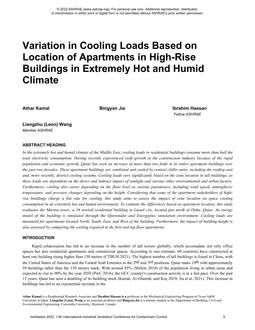Description
Click here to purchase
In the extremely hot and humid climate of the Middle East, cooling loads in residential buildings consume more than half the total electricity consumption. Having recently experienced swift growth in the construction industry because of the rapid population and economic growth, Qatar has seen an increase of more than two folds in its entire apartment buildings over the past two decades. These apartment buildings are ventilated and cooled by central chiller units, including the rooftop unit and, more recently, district cooling systems. Cooling loads vary significantly based on the zone location in tall buildings, as these loads are dependent on the direct and indirect impact of sunlight and various other environmental and urban factors. Furthermore, cooling also varies depending on the floor level as various parameters, including wind speed, atmospheric temperature, and pressure changes depending on the height. Considering that some of the apartment stakeholders of high-rise buildings charge a flat rate for cooling, this study aims to assess the impact of zone location on space cooling consumption in an extremely hot and humid environment. To estimate the differences based on apartment location, this study evaluates the Marina tower, a 16 storied residential building in Lusail city, located just north of Doha, Qatar. An energy model of the building is simulated through the Openstudio and Energyplus simulation environment. Cooling loads are measured for apartments located North, South, East, and West of the building. Furthermore, the impact of building height is also assessed by comparing the cooling required in the first and top floor apartments.
Product Details
- Published:
- 2022
- Number of Pages:
- 8
- Units of Measure:
- Dual
- File Size:
- 1 file , 1.2 MB
- Product Code(s):
- D-IIVC2022-C002
- Note:
- This product is unavailable in Russia, Belarus




